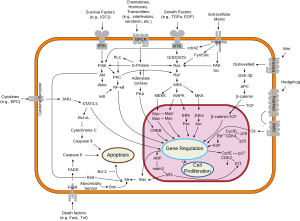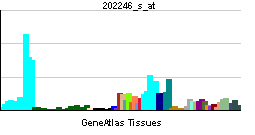Cdk4
La quinasa dependiente de ciclina 4 también conocida como Cdk4, es una enzima que en los humanos es codificado por el gen CDK4. Como su nombre lo indica, la Cdk4 es miembro de la familia de quinasas dependientes de ciclinas y miembro de la familia de las serina/treonina proteína kinasas, que presenta un alto grado de homología con Cdc28 sintetizada por la especie S. cerevisiae y cdc2 de la especie S. pombe.
Función
[editar]La serina/treonina proteína quinasa del Cdk4 es una subunidad catalítica importante para la progresión de la célula por la fase G del ciclo celular. La actividad de esta quinasa está restringida a la fase G1-S, y controlada o modulada por las subunidades regulatorias de la ciclina tipo D y del inhibitor de las Cdk, p16INK4a. Esta quinasa ha sido responsable de la fosforilación de la proteína del retinoblastoma (pRb).[1]
Importancia clínica
[editar]Mutaciones en Cdk4, así como en su proteínas asociadas, incluyendo las ciclinas D, p16 (TINTA4un) y pRb se encuentran en cercana asociación con la carcinogénesis en una variedad de órganos. En este respecto se han descubierto múltiples secuencias del gen CDK4 que son sitios poliadenilación, un proceso que es parte de la expresión genética del gen.[1]
El medicamento Palbociclib, aprobado por la Administración de Alimentos y Medicamentos estadounidense para tratar el cáncer de seno en estadio avanzado (metastásico), tiene una fuerte asociación con Cdk4 y CDK6.[2][3]
Interacciones
[editar]
La quinasa dependiente de ciclina 4 ha demostrado ser capaz de interaccionar con:
- CDC37,[4][5][6][7]
- CDKN1B,[8][9]
- CDKN2B,[10][11]
- CDKN2C,[4][12]
- CEBPA,[13]
- CCND1,[14][15][8][16][9][17]
- CCND3,[10][18][8][19]
- DBNL,[4]
- MyoD,[20][21]
- P16,[4][22][23][14][15][17]
- PCNA,[15][24] and
- SERTAD1.[23][14]
Referencias
[editar]- ↑ a b «Entrez Gene: CDK4 cyclin-dependent kinase 4».
- ↑ Finn, RS; Dering, J; Conklin, D; Kalous, O; Cohen, DJ; Desai, AJ; Ginther, C; Atefi, M et al. (2009). «PD 0332991, a selective cyclin D kinase 4/6 inhibitor, preferentially inhibits proliferation of luminal estrogen receptor-positive human breast cancer cell lines in vitro». Breast cancer research : BCR 11 (5): R77. PMC 2790859. PMID 19874578. doi:10.1186/bcr2419.
- ↑ Rocca A, Farolfi A, Bravaccini S, Schirone A, Amadori D (2014). «Palbociclib (PD 0332991): targeting the cell cycle machinery in breast cancer». Expert Opin Pharmacother 15 (3): 407-20. PMID 24369047. doi:10.1517/14656566.2014.870555.
- ↑ a b c d Ewing RM, Chu P, Elisma F, Li H, Taylor P, Climie S, McBroom-Cerajewski L, Robinson MD, O'Connor L, Li M, Taylor R, Dharsee M, Ho Y, Heilbut A, Moore L, Zhang S, Ornatsky O, Bukhman YV, Ethier M, Sheng Y, Vasilescu J, Abu-Farha M, Lambert JP, Duewel HS, Stewart II, Kuehl B, Hogue K, Colwill K, Gladwish K, Muskat B, Kinach R, Adams SL, Moran MF, Morin GB, Topaloglou T, Figeys D (2007). «Large-scale mapping of human protein-protein interactions by mass spectrometry». Mol. Syst. Biol. 3 (1): 89. PMC 1847948. PMID 17353931. doi:10.1038/msb4100134.
- ↑ Dai K, Kobayashi R, Beach D (1996). «Physical interaction of mammalian CDC37 with CDK4». J. Biol. Chem. 271 (36): 22030-4. PMID 8703009. doi:10.1074/jbc.271.36.22030.
- ↑ Lamphere L, Fiore F, Xu X, Brizuela L, Keezer S, Sardet C, Draetta GF, Gyuris J (1997). «Interaction between Cdc37 and Cdk4 in human cells». Oncogene 14 (16): 1999-2004. PMID 9150368. doi:10.1038/sj.onc.1201036.
- ↑ Stepanova L, Leng X, Parker SB, Harper JW (1996). «Mammalian p50Cdc37 is a protein kinase-targeting subunit of Hsp90 that binds and stabilizes Cdk4». Genes Dev. 10 (12): 1491-502. PMID 8666233. doi:10.1101/gad.10.12.1491.
- ↑ a b c Lin J, Jinno S, Okayama H (2001). «Cdk6-cyclin D3 complex evades inhibition by inhibitor proteins and uniquely controls cell's proliferation competence». Oncogene 20 (16): 2000-9. PMID 11360184. doi:10.1038/sj.onc.1204375.
- ↑ a b Cariou S, Donovan JC, Flanagan WM, Milic A, Bhattacharya N, Slingerland JM (2000). «Down-regulation of p21WAF1/CIP1 or p27Kip1 abrogates antiestrogen-mediated cell cycle arrest in human breast cancer cells». Proc. Natl. Acad. Sci. U.S.A. 97 (16): 9042-6. PMC 16818. PMID 10908655. doi:10.1073/pnas.160016897.
- ↑ a b Rual JF, Venkatesan K, Hao T, Hirozane-Kishikawa T, Dricot A, Li N, Berriz GF, Gibbons FD, Dreze M, Ayivi-Guedehoussou N, Klitgord N, Simon C, Boxem M, Milstein S, Rosenberg J, Goldberg DS, Zhang LV, Wong SL, Franklin G, Li S, Albala JS, Lim J, Fraughton C, Llamosas E, Cevik S, Bex C, Lamesch P, Sikorski RS, Vandenhaute J, Zoghbi HY, Smolyar A, Bosak S, Sequerra R, Doucette-Stamm L, Cusick ME, Hill DE, Roth FP, Vidal M (2005). «Towards a proteome-scale map of the human protein-protein interaction network». Nature 437 (7062): 1173-8. PMID 16189514. doi:10.1038/nature04209.
- ↑ Ghavidel A, Cagney G, Emili A (2005). «A skeleton of the human protein interactome». Cell 122 (6): 830-2. doi:10.1016/j.cell.2005.09.006.
- ↑ Guan KL, Jenkins CW, Li Y, Nichols MA, Wu X, O'Keefe CL, Matera AG, Xiong Y (1994). «Growth suppression by p18, a p16INK4/MTS1- and p14INK4B/MTS2-related CDK6 inhibitor, correlates with wild-type pRb function». Genes Dev. 8 (24): 2939-52. PMID 8001816. doi:10.1101/gad.8.24.2939.
- ↑ Wang H, Iakova P, Wilde M, Welm A, Goode T, Roesler WJ, Timchenko NA (2001). «C/EBPalpha arrests cell proliferation through direct inhibition of Cdk2 and Cdk4». Mol. Cell 8 (4): 817-28. PMID 11684017. doi:10.1016/S1097-2765(01)00366-5.
- ↑ a b c Sugimoto M, Nakamura T, Ohtani N, Hampson L, Hampson IN, Shimamoto A, Furuichi Y, Okumura K, Niwa S, Taya Y, Hara E (1999). «Regulation of CDK4 activity by a novel CDK4-binding protein, p34(SEI-1)». Genes Dev. 13 (22): 3027-33. PMC 317153. PMID 10580009. doi:10.1101/gad.13.22.3027.
- ↑ a b c Nasmyth K, Hunt T (1993). «Cell cycle. Dams and sluices». Nature 366 (6456): 634-5. doi:10.1038/366634a0.
- ↑ Taulés M, Rius E, Talaya D, López-Girona A, Bachs O, Agell N (1998). «Calmodulin is essential for cyclin-dependent kinase 4 (Cdk4) activity and nuclear accumulation of cyclin D1-Cdk4 during G1». J. Biol. Chem. 273 (50): 33279-86. PMID 9837900. doi:10.1074/jbc.273.50.33279.
- ↑ a b Coleman KG, Wautlet BS, Morrissey D, Mulheron J, Sedman SA, Brinkley P, Price S, Webster KR (1997). «Identification of CDK4 sequences involved in cyclin D1 and p16 binding». J. Biol. Chem. 272 (30): 18869-74. PMID 9228064. doi:10.1074/jbc.272.30.18869.
- ↑ Arsenijevic T, Degraef C, Dumont JE, Roger PP, Pirson I (2004). «A novel partner for D-type cyclins: protein kinase A-anchoring protein AKAP95». Biochem. J. 378 (Pt 2): 673-9. PMC 1223988. PMID 14641107. doi:10.1042/BJ20031765.
- ↑ Zhang Q, Wang X, Wolgemuth DJ (1999). «Developmentally regulated expression of cyclin D3 and its potential in vivo interacting proteins during murine gametogenesis». Endocrinology 140 (6): 2790-800. PMID 10342870. doi:10.1210/endo.140.6.6756.
- ↑ Zhang JM, Zhao X, Wei Q, Paterson BM (1999). «Direct inhibition of G(1) cdk kinase activity by MyoD promotes myoblast cell cycle withdrawal and terminal differentiation». EMBO J. 18 (24): 6983-93. PMC 1171761. PMID 10601020. doi:10.1093/emboj/18.24.6983.
- ↑ Zhang JM, Wei Q, Zhao X, Paterson BM (1999). «Coupling of the cell cycle and myogenesis through the cyclin D1-dependent interaction of MyoD with cdk4». EMBO J. 18 (4): 926-33. PMC 1171185. PMID 10022835. doi:10.1093/emboj/18.4.926.
- ↑ Fåhraeus R, Paramio JM, Ball KL, Laín S, Lane DP (1996). «Inhibition of pRb phosphorylation and cell-cycle progression by a 20-residue peptide derived from p16CDKN2/INK4A». Curr. Biol. 6 (1): 84-91. PMID 8805225. doi:10.1016/S0960-9822(02)00425-6.
- ↑ a b Li J, Melvin WS, Tsai MD, Muscarella P (2004). «The nuclear protein p34SEI-1 regulates the kinase activity of cyclin-dependent kinase 4 in a concentration-dependent manner». Biochemistry 43 (14): 4394-9. PMID 15065884. doi:10.1021/bi035601s.
- ↑ Xiong Y, Zhang H, Beach D (1993). «Subunit rearrangement of the cyclin-dependent kinases is associated with cellular transformation». Genes Dev. 7 (8): 1572-83. PMID 8101826. doi:10.1101/gad.7.8.1572.

